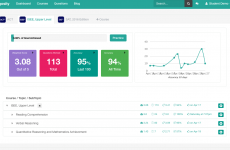PROS of Khan Academy
- It is free and accessible. It costs absolutely nothing to watch videos and work on problems. It is available anywhere with internet.
- There are a wide variety of subjects available. There are videos about math, biology, chemistry, and physics. In addition, there are also videos on arts, humanities, economics, and finance. Khan Academy is continually growing, so new subjects and videos are added regularly.
- You can learn and work at your own pace. You can fast forward, rewind, repeat videos, stop and work out a problem on your own, all without having to consider other students’ or the teacher’s pace. Those who naturally work slower or who are struggling with a particular topic can focus on that topic. Others who may be naturally adept at a certain topic can speed through sections that are less challenging.
- It provides an incredible amount of math problems for a variety of grade levels (from very basic elementary concepts through calculus). One of the best ways to learn is through repetition. The more you do a certain kind of problem, the more familiar you will be with it, and the more you can use the patterns you recognize as a template for solving future problems. Because each problem is randomly generated, you have an unlimited number of problems to practice with. Each problem also is accompanied by its own solution so you can break it down step-by-step.
CONS of Khan Academy
- It is less interactive than having a face-to-face teacher or tutor. With a physical teacher or a tutor, you receive immediate feedback and talk through your thought process. With the Khan Academy videos, you lose that interactivity. If you have a question about a certain concept or problem, you cannot talk to another person and have them elaborate. Its much more difficult for your to work through problem solving processes alone, in order to gauge your understanding.
- You are only exposed to one teaching style. Some students are auditory learners, others are visual, some are kinetic, and many students are a mix. Some students learn best with examples, some students learn best by doing. With Khan Academy, you are restricted to learning how the video teaches you, and it may or may not be the best way for you to learn as an individual.
- You lose the collaborative aspect of education. A perk of being in the classroom or one-on-one is that you can bounce ideas off of each other and work together. You might discover a new way of thinking about something or help one another build off of your mutual knowledge, skills, or strengths and weaknesses. That process cannot be replicated in the same way, when learning from videos.
- It lessens spontaneous creativity. Khan Academy, by nature, takes away some of the creativity and innovation that develops as you learn. It can only instruct; it cannot inspire and guide you to come to a solution on your own. A fundamental part of education is not only learning the material—in conjunction with generating ideas and being able to execute them.
In summary, Khan Academy is an incredibly useful tool for individuals to use to supplement concepts learned in class or find extra problems to work. However, it cannot replace the traditional classroom and tutoring experience.
















Pingback: Misconceptions and Facts: Lies and Truth About the Business of Modeling